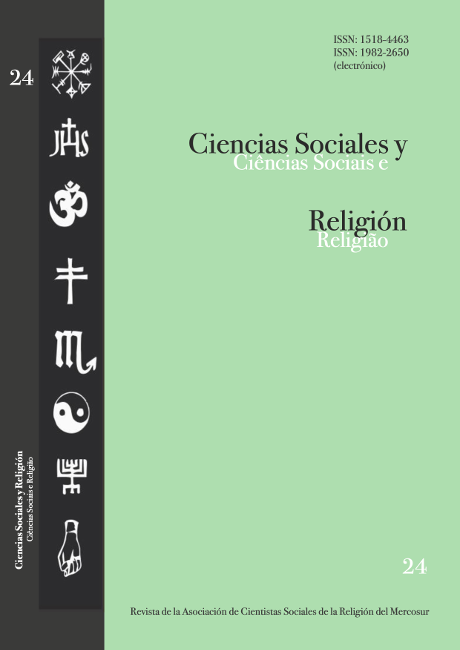Abstract
The ritual sweatlodge (temazcal or inipi) has been transculturalized: is now present in multiple spaces, promoted by alternative spirituality groups. We describe ethnographically three cases, where the most influencial currents in the transculturalization of this ritual can be appreciated: Mexicanidad , New Mexicanidad and Red Path movements; the alternative pschotherapeutic circles; and the new age comercial network of holistic health and wellbeing products and services. During the ethnographic work we focus our attention in the body experiences, since the body is constituted as the locus of re-connection with a cosmized and sacralized nature. Through comparison with its features as a traditional practice in the rural Indian communities of Mexico, we approached to the typical orientations of its resignification in order to distinguish the meaningful elements and ritual modalities specific to the contemporary spiritual networks.
References
AMARAL, Leila. Sincretismo em movimento: o estilo Nova Era de lidar com o sagrado. En: CAROZZI, María Julia (Org.).A Nova Era no Mercosul. Petrópolis:Editora Vozes, 1999. pp. 47-80.
APARICIO MENA, Alfonso Julio. El temazcal en la cultura tradicional de salud y la etnomedicina mesoamericana. Gazeta de Antropología, n. 22, artículo 16, 2006
ARIAS, Patricia; DURAND, J. La enferma eterna. Mujer y exvoto en México, Siglos XIX y XX. Guadalajara: Universidad de Guadalajara/El Colegio de San Luis, 2002.
ARIZPE, Lourdes. El patrimonio cultural inmaterial de México. Ritos y festividades. México: Miguel Ángel Porrúa,2009.
BERGER, Peter. El Dosel Sagrado. Barcelona: Kairós, 2006 [1967].
CAROZZI, María Julia. La autonomía como religión: la Nuera Era. Alteridades. Antropología de los movimientos religiosos, México, año 9, n. 18, pp.19-38.1999.
CSORDAS, Thomas. Embodiment and Experience. The Existential Ground of Culture and Self.Cambridge: Cambridge University Press, 1994.
DE LA PEÑA, Francisco. Los hijos del sexto sol.México:INAH,2002.
DE SOUSA SANTOS, Boaventura. Una Epistemología del Sur. La reinvención del Conocimiento y la Emancipación Social. Buenos Aires:Siglo XXI Editores, CLACSO, 2009.
HEELAS, Paul. Spiritualities of Life: New Age Romanticism and Consumptive Capitalism. Oxford: Blackwell Publishers, 2008.
GALINIER, Jacques. La moitié du monde. Le corps et le cosmos dans le rituel des indiensotomi. París: Presses Universitaires de France, 1997.
GALINIER, Jacques. Indio de estado versus indio nacional en la Mesoamérica moderna. En: ARGYRIADIS, Kali; DE LA TORRE, R; GUTIÉRREZ ZÚÑIGA, C; AGUILAR ROS, A. (Org.). Raíces en movimiento. Prácticas religiosas tradicionales en contextos translocales. Guadalajara: El Colegio de Jalisco/CEMCA/CIESAS/IRD/ITESO, 2008. p.45-72.
GOOREN, Henri P.P. (ed.), Encyclopedia of Latin American Religions, USA: Springer International Publishing, 2015.
MCGUIRE, Meredith. Lived Religion. Faith and Practice in Everyday Life.Oxford: Oxford University Press, 2008.
RAMÍREZ, Rosario. Círculos de mujeres y el cuerpo femenino como espacio de significación espiritual. En: PARRINI, Rodrigo; GOLUBOV,N (Org.). Meridiano Cero. Globalización, prácticas culturales y nuevas territorializaciones simbólicas. México: Centro de Investigaciones sobre América del Norte, Universidad Nacional Autónoma de México, en prensa.

This work is licensed under a Creative Commons Attribution-NonCommercial-ShareAlike 4.0 International License.
Copyright (c) 2020 Renée De la Torre Castellanos, Cristina Gutiérrez Zuñiga
